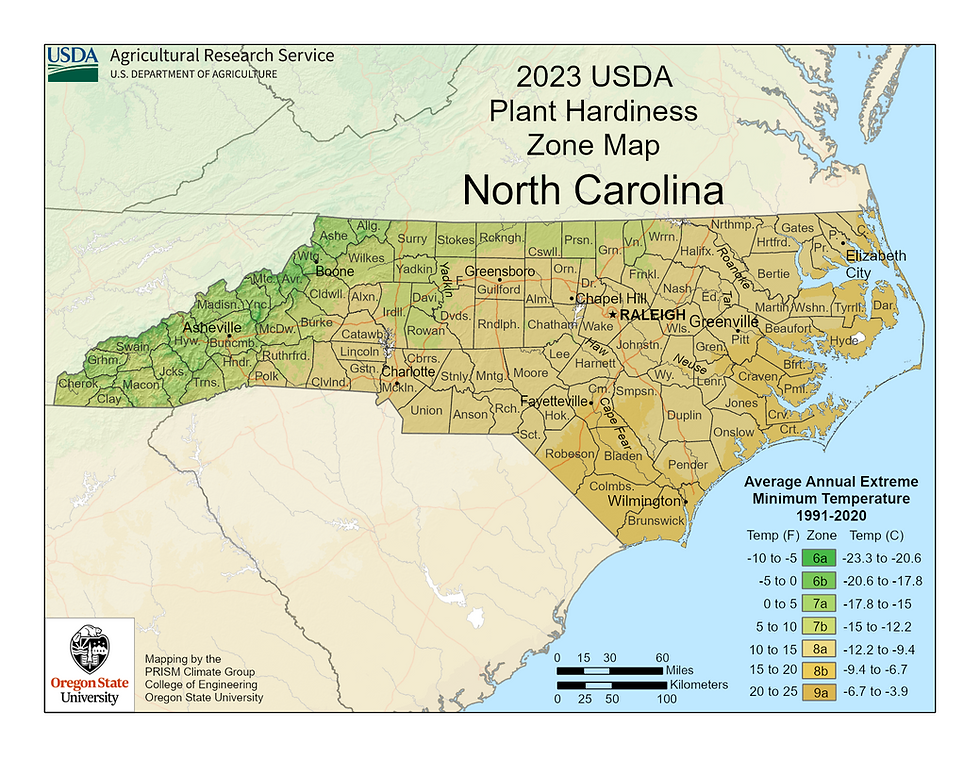USDA Hardiness Zones Across the U.S. - Spotlight on North Carolina!
- Marcus Bergin

- Aug 14, 2024
- 3 min read
Discover Your USDA Hardiness Zone!
Are you ready to create a flourishing garden in North Carolina? Understanding your USDA Hardiness Zone is essential for selecting plants that can thrive in the state’s varied climate, from the cool mountains to the warm coastal plains. Let’s explore the zones across North Carolina and find the best shade-tolerant plants for your garden!

North Carolina: Zones 6-8
North Carolina’s climate ranges from the cooler, mountainous areas in the west to the warmer, humid coastal regions in the east. Here’s a closer look at the zones in North Carolina and some shade-tolerant plants that will thrive in each:
Zone 6:
Found in the higher elevations of the Appalachian Mountains, including areas like Asheville and Boone, where winter temperatures can drop to -10 to 0°F. These shade-tolerant plants are perfect for the cooler areas:
Hostas (Hosta spp.): A classic choice for shade gardens, Hostas offer lush foliage in a variety of colors and patterns, thriving in the cool, shaded areas of Zone 6.
Ferns: Varieties like Christmas Fern (Polystichum acrostichoides) and Maidenhair Fern (Adiantum spp.) bring lush greenery to shaded garden spots.
Bleeding Heart (Dicentra spectabilis): Known for its heart-shaped flowers, Bleeding Heart is a perfect choice for shady areas in spring and early summer.
Zone 7:
Covers much of central North Carolina, including cities like Charlotte, Raleigh, and Greensboro, with winter temperatures ranging from 0 to 10°F. This zone is ideal for a variety of shade-tolerant plants:
Azaleas (Rhododendron spp.): A popular choice for North Carolina gardens, Azaleas offer vibrant blooms in spring and thrive in the acidic, shaded soils typical of this region.
Rhododendrons (Rhododendron spp.): Known for their large, showy blooms, Rhododendrons are perfect for shaded areas and thrive in the mild climate of Zone 7.
Coral Bells (Heuchera spp.): Prized for their colorful foliage, Coral Bells add visual interest and texture to shaded garden spots.
Zone 8:
Found in the southeastern parts of North Carolina, including the coastal plains and areas around Wilmington, where winter temperatures range from 10 to 20°F. This warmer zone supports a wide variety of shade-tolerant plants:
Hydrangeas (Hydrangea spp.): With their large, colorful blooms, Hydrangeas thrive in the humid climate of Zone 8, adding a splash of color to shaded garden spots.
Camellias (Camellia spp.): With their glossy evergreen leaves and stunning winter and early spring flowers, Camellias are perfect for bringing year-round beauty to shaded areas.
Liriope (Liriope muscari): Also known as lilyturf, this hardy groundcover is excellent for filling in shaded garden beds, producing spikes of lavender flowers in late summer.
Why It Matters:
Optimal Plant Selection: Choosing plants that are well-suited to your specific zone ensures they will thrive and contribute to a healthy, beautiful garden.
Effective Garden Planning: Understanding your zone helps you plan your planting schedule, allowing you to take full advantage of North Carolina’s long growing season.
Sustainable Gardening: By selecting plants that naturally thrive in your zone’s conditions, you reduce the need for extra water, fertilizers, and pesticides, promoting a more eco-friendly garden.
Get Involved: Share Your Gardening Experience
We want to hear from you! Whether you’re gardening in the cool mountains of Zone 6 or the warmer, coastal areas of Zone 8, your experiences and tips can inspire and guide others.
Join the Conversation:
Comment Below: Share your gardening successes, challenges, and questions with fellow North Carolina gardeners.
Join Our Facebook Group: Connect with a community of shade gardening enthusiasts by joining our Shade Gardening Group on Facebook. It’s a great place to exchange ideas, find inspiration, and support your gardening journey.
Let’s grow together, North Carolina! 🌻




Comments